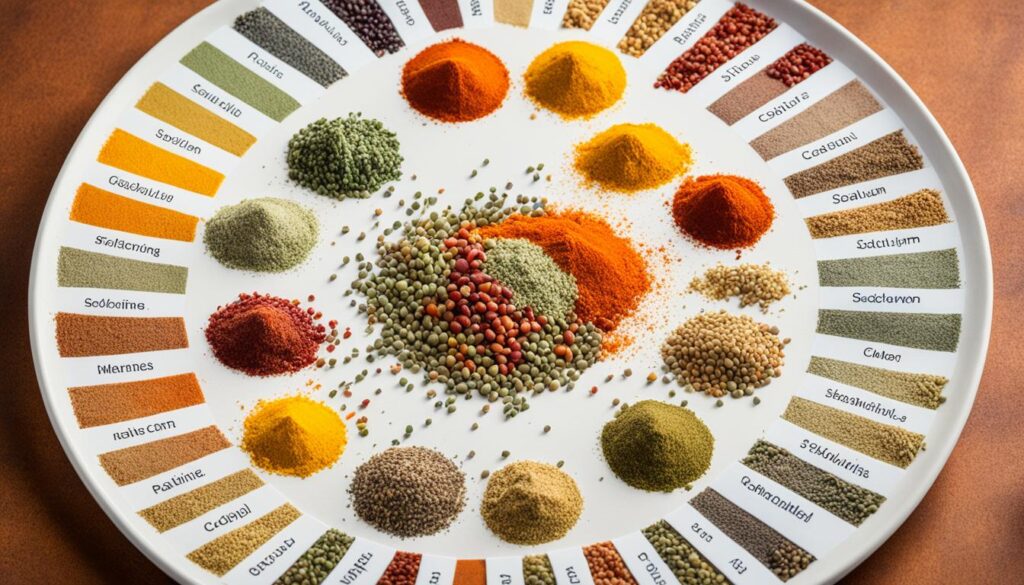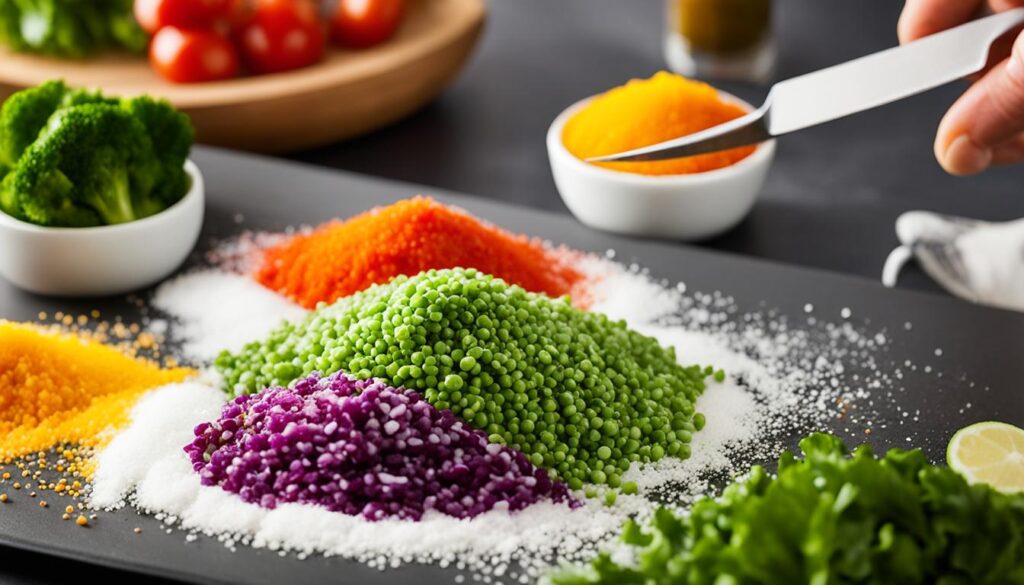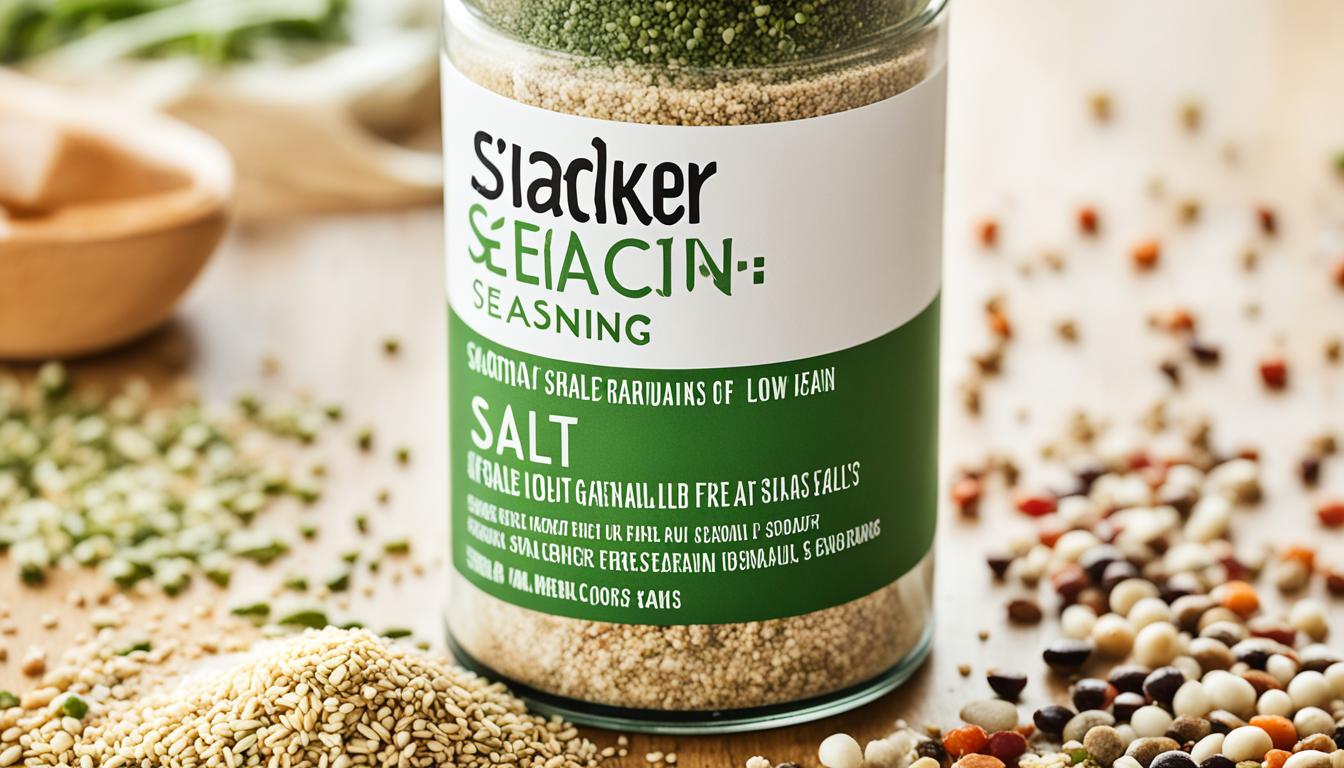Did you know that the average American consumes more than double the recommended daily amount of sodium? Excessive sodium intake can have detrimental effects on your health, particularly regarding heart health. But that doesn’t mean you have to sacrifice flavor in your meals. Discover the best low sodium seasoning salt options that not only taste delicious but also support a heart-healthy diet.
By incorporating these healthier alternatives, you can enhance the taste of your dishes while reducing your sodium intake. Let’s explore the top brands and blends of low sodium seasoning salt that offer a satisfying and healthy flavor profile.
Key Takeaways:
- Excessive sodium intake can have negative effects on health, particularly heart health.
- Low sodium seasoning salts provide a flavorful alternative without compromising taste.
- Incorporating low sodium seasoning salt into your meals can help reduce sodium intake.
- There are several top brands and blends of low sodium seasoning salt available.
- Choosing a low sodium option allows you to personalize your pantry and enjoy a wide range of flavors.
The Importance of Reducing Sodium in Your Diet
Sodium is an essential mineral that plays a vital role in maintaining proper bodily functions. It helps regulate fluid balance, nerve transmission, and muscle contractions. However, consuming too much sodium can have detrimental effects on your health, particularly on your heart.
Excessive sodium intake can contribute to high blood pressure, which is a major risk factor for heart disease and stroke. It can also lead to fluid retention, causing swelling and putting strain on the heart and blood vessels. To protect your heart health and overall well-being, it is crucial to reduce your sodium intake and make conscious choices in your diet.
Understanding Sodium’s Impact on Health
High levels of sodium in the diet have been linked to an increased risk of hypertension and cardiovascular disease. This is because sodium attracts water and excess sodium in the bloodstream can cause the body to retain fluid, increasing blood volume and putting pressure on blood vessels. Over time, this can lead to the development of high blood pressure and the subsequent risk of heart disease, stroke, and other cardiovascular problems.
Reducing sodium in your diet can help lower your blood pressure and promote heart health. By consuming less sodium, you decrease the volume of fluid in your bloodstream, reducing the strain on your cardiovascular system. This, in turn, helps prevent the onset of heart diseases and maintains a healthy blood pressure level.
Making Health-Conscious Choices by Cutting Back on Salt
The primary source of sodium in our diets is table salt, which is why cutting back on added salt is crucial for reducing your sodium intake. Sodium is also found in processed foods, such as canned soups, deli meats, and fast food. Making health-conscious choices involves reading food labels and actively choosing low-sodium options.
Opting for fresh, whole foods and cooking from scratch allows you to have better control over the sodium content in your meals. By using herbs, spices, and flavorful low sodium seasonings, you can still enjoy delicious meals while reducing your sodium intake. Making gradual changes and experimenting with different seasonings can help you find healthier alternatives that suit your taste preferences.
| Health Impact of Sodium | Healthy Choices |
|---|---|
| Increased risk of high blood pressure | Reduce sodium intake and opt for low sodium alternatives |
| Fluid retention and swelling | Choose fresh, whole foods and cook from scratch |
| Strain on the heart and blood vessels | Read food labels and avoid processed foods |
| Risk factors for heart disease and stroke | Use herbs, spices, and low sodium seasonings |
Discovering Flavorful Alternatives with Low Sodium Seasoning Salt
Finding flavorful alternatives to traditional high sodium seasonings is key for those looking to reduce their sodium intake. Understanding what makes a seasoning low in sodium allows you to choose wisely. In this section, we’ll explore the characteristics of low sodium seasonings and highlight popular brands and blends that offer a wide range of delicious options without compromising on taste.
What Makes a Seasoning Low in Sodium?
Low sodium seasonings are specially formulated to contain significantly less salt than their traditional counterparts. They are created using alternative ingredients and flavorings that add depth and complexity to your dishes without relying on high sodium content. These seasonings often incorporate herbs, spices, and other natural flavor enhancers to provide a burst of taste. By using sophisticated blending techniques, low sodium seasoning manufacturers can produce products that deliver on flavor without the need for excessive sodium.
Popular Low Sodium Seasoning Brands and Blends
When it comes to low sodium seasonings, some several popular brands and blends have gained recognition for their flavorful offerings. These brands use a combination of herbs, spices, and other natural ingredients to create unique and mouthwatering blends. Some of the popular low sodium seasoning brands include:
- **Mrs. Dash**: Known for their wide range of sodium-free alternatives, Mrs. Dash offers a variety of delicious seasoning blends that cater to different flavor preferences.
- **Flavor God**: Flavor God spices are crafted with a focus on flavor without sacrificing health-conscious ingredients. Their blends are free of gluten, MSG, and contain no sodium or preservatives.
- **Simply Organic**: Offering a range of organic seasonings, Simply Organic provides options that are low in sodium and made from high-quality, organic ingredients.
- **Penzeys Spices**: Penzeys Spices offers a diverse selection of low sodium blends that are created using fresh, high-quality ingredients. Their seasonings are known for their rich flavors.
These brands, among others, have paved the way in producing low sodium seasoning options that are both healthy and delicious. By incorporating these brands into your cooking, you can enjoy a wide range of flavors without compromising your sodium intake.
Exploring the World of DAK’s Spices: A Salt-Free Sensation
The Birth of DAK’s Spices: Motivation and Mission
DAK’s Spices is a family-owned company that has gained recognition for its flavorful salt-free seasonings. The story of DAK’s Spices began with a simple yet powerful motivation—to provide delicious seasonings that are not only packed with flavor but also low in sodium. Recognizing the need for flavorful options for individuals following a low sodium diet, the founders of DAK’s Spices set out on a mission to create seasonings that would allow people to enjoy the same great taste without the added salt.
Driven by a passion for healthy and flavorful cooking, DAK’s Spices is committed to offering a wide range of salt-free seasonings that cater to various taste preferences and dietary needs. With their carefully crafted blends, DAK’s Spices aims to provide the perfect solution for those seeking flavorful alternatives for low sodium cooking.
Experience Flavor Without the Salt – How to Use DAK’s
Incorporating DAK’s Spices into your cooking is incredibly easy and rewarding. Whether you’re grilling, baking, or simply seasoning your everyday meals, DAK’s Spices offers a versatile range of options to enhance your dishes with flavor without the added salt.
“With DAK’s Spices, you can savor the essence of herbs, spices, and other natural ingredients, allowing the true flavors of your favorite dishes to shine. By exploring the world of DAK’s Spices, you can elevate your culinary creations and embrace a low sodium lifestyle without compromising on taste.”
To use DAK’s Spices, simply sprinkle the desired blend onto your food during the cooking process or as a finishing touch. The diverse range of salt-free seasonings from DAK’s Spices ensures that there’s something for every palate. From savory blends for meats and roasted vegetables to zesty options for seafood and salads, DAK’s Spices offers a wide array of flavors to suit your culinary preferences.
By incorporating DAK’s Spices into your cooking, you can not only enjoy the benefits of reduced sodium intake but also create tantalizing dishes that are bursting with flavor. DAK’s Spices empowers you to infuse your meals with bold tastes and aromatic profiles, all while adhering to a low sodium lifestyle.

Personalizing Your Pantry: Choosing the Right Low Sodium Seasonings
When it comes to seasonings, everyone has their own unique taste preferences. Whether you enjoy bold and spicy flavors or prefer milder options, choosing the right low sodium seasonings can personalize your pantry and enhance your dining experience. In this section, we’ll take a comparative look at popular brands like Mrs. Dash and others, helping you find the perfect low sodium seasonings that match your seasoning preferences.
Mrs. Dash and Other Brands: A Comparative Look
One of the well-known brands in the low sodium seasoning market is Mrs. Dash. Known for their salt-free blends, Mrs. Dash offers a variety of flavors that are perfect for those watching their sodium intake. Their seasonings often contain a combination of herbs, spices, and natural flavors to create a tasty and low sodium alternative to traditional seasoning salts.
However, Mrs. Dash is not the only option available. Other brands offer a wide range of low sodium seasoning blends to suit your taste preferences. Consider exploring brands like Chef Paul Prudhomme’s Magic Seasoning, Benson’s Gourmet Seasonings, and McCormick’s Perfect Pinch for additional options. Each brand brings its own unique flavor profiles and ingredients to the table, providing a diverse selection for you to personalize your pantry.
Tailoring Seasonings to Your Taste Preferences
Personalizing your pantry means finding low sodium seasonings that align with your specific taste preferences. While some people enjoy the bold and robust flavors of certain seasonings, others may prefer milder options that enhance the natural taste of their dishes. By understanding your seasoning preferences, you can select the right low sodium options that will elevate your cooking.
Consider the flavor profiles that resonate with you. Are you a fan of spicy seasonings? Or maybe you prefer a blend of savory herbs and zesty citrus flavors. Take note of the ingredients present in different low sodium seasonings and experiment with different combinations to find the perfect balance for your palate.
Additionally, be mindful of any dietary restrictions or allergies. Some low sodium seasonings may contain ingredients that may not be suitable for certain dietary needs. Always check the product labels and consult with your healthcare provider if you have any concerns.
Remember, personalizing your pantry is all about tailoring your seasonings to your taste preferences. Whether you choose Mrs. Dash or other brands, exploring different low sodium options allows you to discover your favorite flavors and create a dining experience that is uniquely yours.

| Brand | Flavor | Ingredients |
|---|---|---|
| Mrs. Dash | Various blends including Italian Medley, Lemon Pepper, and Garlic & Herb | Herbs, spices, natural flavors |
| Chef Paul Prudhomme’s Magic Seasoning | Blackened Redfish Magic, Poultry Magic, and Seafood Magic> | Spices, herbs, salt-free seasonings |
| Benson’s Gourmet Seasonings | Original, Herb Garden, and No Salt & No Sugar | Herbs, spices, flavorings |
| McCormick’s Perfect Pinch | Original, Lemon & Pepper, and Garlic & Herb | Herbs, spices, natural flavors |
The Global Palate: Exotic and Low Sodium Spice Blends
Spices are an essential part of many international cuisines. They add depth, complexity, and unique flavors to dishes from around the world. However, traditional spice blends often contain high amounts of sodium, which can be detrimental to our health. Luckily, there is a wide variety of low sodium global spice blends available, allowing you to indulge in international flavors while maintaining a heart-healthy diet.
Embark on a Culinary Journey with Salt-Free International Flavors
Exploring different cuisines is like embarking on a culinary journey, where each dish tells a story about a specific culture and its rich history. By incorporating low sodium spice blends from various countries, you can take your taste buds on a global adventure without worrying about excessive sodium intake. From the bold and aromatic spices of India to the complex and vibrant flavors of Mexico, the world is your oyster when it comes to creating delicious and healthy meals.
Bring the heat and smokiness of Moroccan cuisine to your kitchen with a salt-free Ras El Hanout spice blend. This fragrant mix of spices, such as cumin, coriander, and cinnamon, will transport you to the bustling streets of Marrakech with its exotic aroma and robust flavors. Or, if you’re craving a taste of the Caribbean, try a salt-free jerk seasoning blend. Packed with allspice, thyme, and scotch bonnet peppers, this spice mix will add a fiery kick to your dishes, reminiscent of the tropical islands.
Whether you’re a fan of Asian, Mediterranean, or South American cuisine, there are low sodium global spice blends available to suit every palate. By incorporating these international flavors into your cooking, you can elevate your meals and satisfy your taste buds, all while maintaining a low sodium diet.
Highlight on Popular Global Spice Mixes Without Sodium
When it comes to popular low sodium global spice blends, there are a few names that stand out for their exceptional flavors and versatility. These spice mixes have gained worldwide recognition for their ability to add depth and complexity to dishes without the need for excess salt.
One such example is Garam Masala, a staple in Indian cuisine. This aromatic blend of spices, including cardamom, cinnamon, and cloves, creates a warm and savory flavor profile that is perfect for curries, soups, and marinades. With a low sodium version of Garam Masala, you can experience the authentic taste of Indian cuisine while keeping your sodium intake in check.
Another popular global spice mix is Italian seasoning, which combines herbs such as basil, oregano, and rosemary to create a versatile blend that works well in pasta sauces, dressings, and roasted vegetables. By choosing a salt-free version of Italian seasoning, you can enjoy the classic flavors of Italy without worrying about the negative health impacts of excessive sodium.
These are just a few examples of the many low sodium global spice blends available. By incorporating these popular salt-free spice mixes into your culinary repertoire, you can travel the world through your taste buds while maintaining a heart-healthy diet.

| Spice Blend | Country of Origin | Flavor Profile | Usage |
|---|---|---|---|
| Ras El Hanout | Morocco | Warm, aromatic, and slightly sweet | Perfect for seasoning diet, vegetables, and rice dishes |
| Jerk Seasoning | Jamaica | Fiery, smoky, and tangy | Ideal for marinating meats, adding a kick to grilled and roasted dishes |
| Garam Masala | India | Warm, complex, and savory | Traditionally used in curries, stews, and lentil dishes |
| Italian Seasoning | Italy | Herbaceous, aromatic, and versatile | Great for pasta sauces, dressings, and roasted vegetables |
Table: Popular Low Sodium Global Spice Blends
Cooking Tips: Incorporating Low Sodium Seasonings in Recipes
Cooking with low sodium seasonings requires some adjustments and creativity. Fortunately, there are plenty of salt-free alternatives available that can enhance the flavors of your dishes without compromising taste or enjoyment. By incorporating these low sodium seasonings into your recipes, you can create delicious and heart-healthy meals. Here are some practical tips to help you get started:
How to Enhance Dishes Using Salt-Free Alternatives
When cooking with low sodium seasonings, it’s important to compensate for the lack of salt by maximizing other flavors. Here are some tips to enhance your dishes:
- Experiment with fresh herbs and spices: Replace salt with a variety of herbs and spices to add depth and complexity to your dishes. Use ingredients like garlic, onion, cilantro, basil, oregano, cumin, and paprika to create flavorful combinations.
- Balance flavors with acidity: Incorporate citrus juices, vinegar, or yogurt to add tanginess and brightness to your recipes. The acidity can help elevate the taste and make up for the absence of salt.
- Layer the flavors: Build layers of flavor by adding ingredients like caramelized onions, roasted garlic, or sautéed mushrooms. These additions can enhance the taste profile of your dishes and make them more satisfying.
- Use salt-free seasoning blends: Look for commercially available salt-free seasoning blends that offer a wide range of flavors. These blends are often expertly crafted to provide a balanced taste without relying on salt.
With these tips, you’ll be able to create dishes that are bursting with flavor even without the use of traditional high-sodium seasonings.
Adapting Classic Recipes for a Low Sodium Diet
If you have favorite recipes that are typically high in sodium, you can adapt them to fit a low sodium diet. Here’s how:
- Gradually reduce salt: Start by gradually reducing the amount of salt called for in the recipe. Over time, your taste buds will adjust, and you’ll find that you need less salt to enjoy the flavors of the dish.
- Enhance with alternatives: Replace salt with low sodium seasonings, herbs, and spices to add flavor to your dishes. Experiment with different combinations to find the ones that suit your taste preferences.
- Choose low sodium ingredients: Opt for low sodium versions of ingredients like broths, canned goods, and condiments. These substitutions can help reduce the overall sodium content of your dish.
- Focus on natural flavors: Emphasize the natural flavors of the ingredients by using cooking methods like roasting, grilling, or sautéing. These techniques can enhance the taste of the ingredients without relying on excessive salt.
By adapting classic recipes to fit a low sodium diet, you can enjoy your favorite dishes while still prioritizing your health.

Transitioning to a Low-Sodium Lifestyle: Strategies and Substitutions
Transitioning to a low-sodium lifestyle can be a transformative journey for your health. By reducing your sodium intake and making conscious choices, you can move towards a healthier lifestyle. Here are some practical strategies and substitutions to help you successfully transition:
1. Gradually Reduce Sodium Intake: A sudden drastic reduction in sodium may be challenging. Start by gradually reducing the amount of salt in your meals and snacks. This gradual approach will allow your taste buds to adjust and help you stick to your low-sodium goals.
2. Experiment with Low Sodium Seasonings: Explore the wide range of low sodium substitutes available in the market. Experiment with herbs, spices, and salt-free seasoning blends to add delicious flavor to your dishes without compromising on taste. Check out the variety of options offered by reputable brands.
3. Read Food Labels: Become a mindful shopper by reading food labels carefully. Look for products that are low in sodium or labeled as “no added sodium.” Pay attention to the sodium content per serving and aim for options with lower sodium levels.
4. Cook Fresh and Homemade: Transitioning to a low-sodium lifestyle is easier when you cook fresh meals at home. By preparing your own meals, you have control over the ingredients and can use low sodium substitutes to maintain flavor. Explore new recipes and experiment with different ingredients to create delicious, low-sodium dishes.
5. Increase Fresh Fruit and Vegetable Intake: Fresh fruits and vegetables are naturally low in sodium and are an essential part of a healthy low-sodium diet. Incorporate a variety of colorful produce into your meals to add nutrients, flavor, and texture. This will help you reduce the need for added salt.
6. Hydrate Adequately: Proper hydration is essential for a healthy lifestyle. Drinking an adequate amount of water can help flush out excess sodium from the body. Aim for at least 8 glasses of water per day to support your low-sodium goals.
By implementing these strategies and making thoughtful substitutions, you can successfully transition to a low-sodium lifestyle. Remember, small changes over time can lead to significant long-term health benefits. Take the first step towards reducing your sodium intake and embrace a healthier, flavorful way of living.
Conclusion
In conclusion, low sodium seasoning salts provide a healthy and flavorful alternative to traditional high sodium seasonings. By understanding the importance of reducing sodium in your diet and exploring the wide variety of low sodium options available, you can make informed choices that promote overall well-being.
By incorporating low sodium seasonings into your cooking, you can enhance the taste of your dishes while reducing your sodium intake, making it easier to maintain a heart-healthy diet. Personalize your pantry with a range of low sodium seasonings, tailoring them to your specific taste preferences for a personalized and enjoyable dining experience.
Don’t limit yourself to just local flavors. Discover the world of low sodium spice blends, and embark on a culinary journey with exotic and flavorful international tastes. Whether it’s Mediterranean herbs, Indian spices, or Asian seasonings, there are popular low sodium options available to add excitement and depth to your dishes.
Transitioning to a low sodium lifestyle can be challenging, but it’s achievable with the right strategies and substitutions. Reduce your sodium intake by incorporating low sodium substitutes and adopting healthier cooking techniques. By making these small changes, you can enjoy delicious, heart-healthy meals without compromising on flavor.




